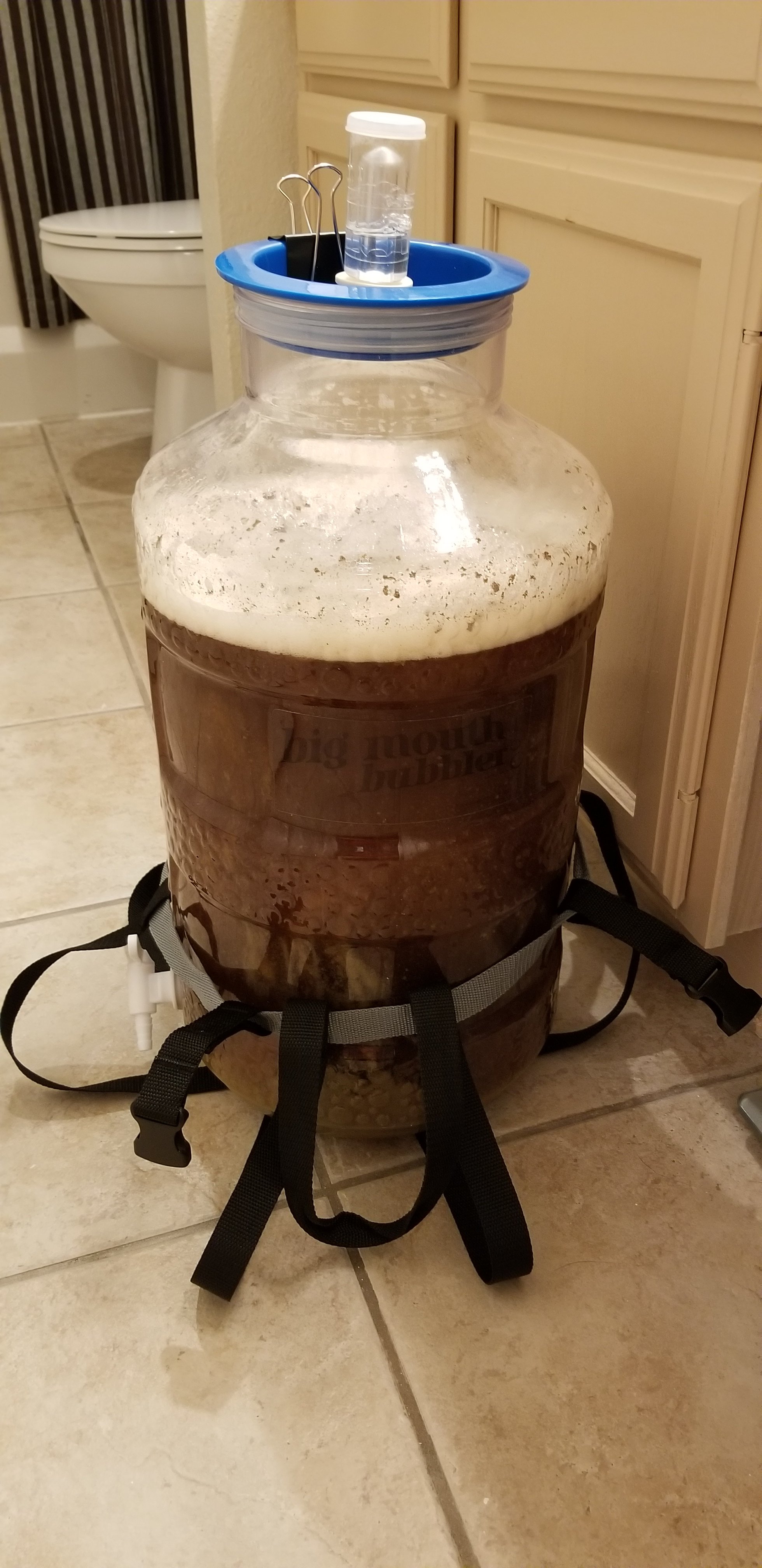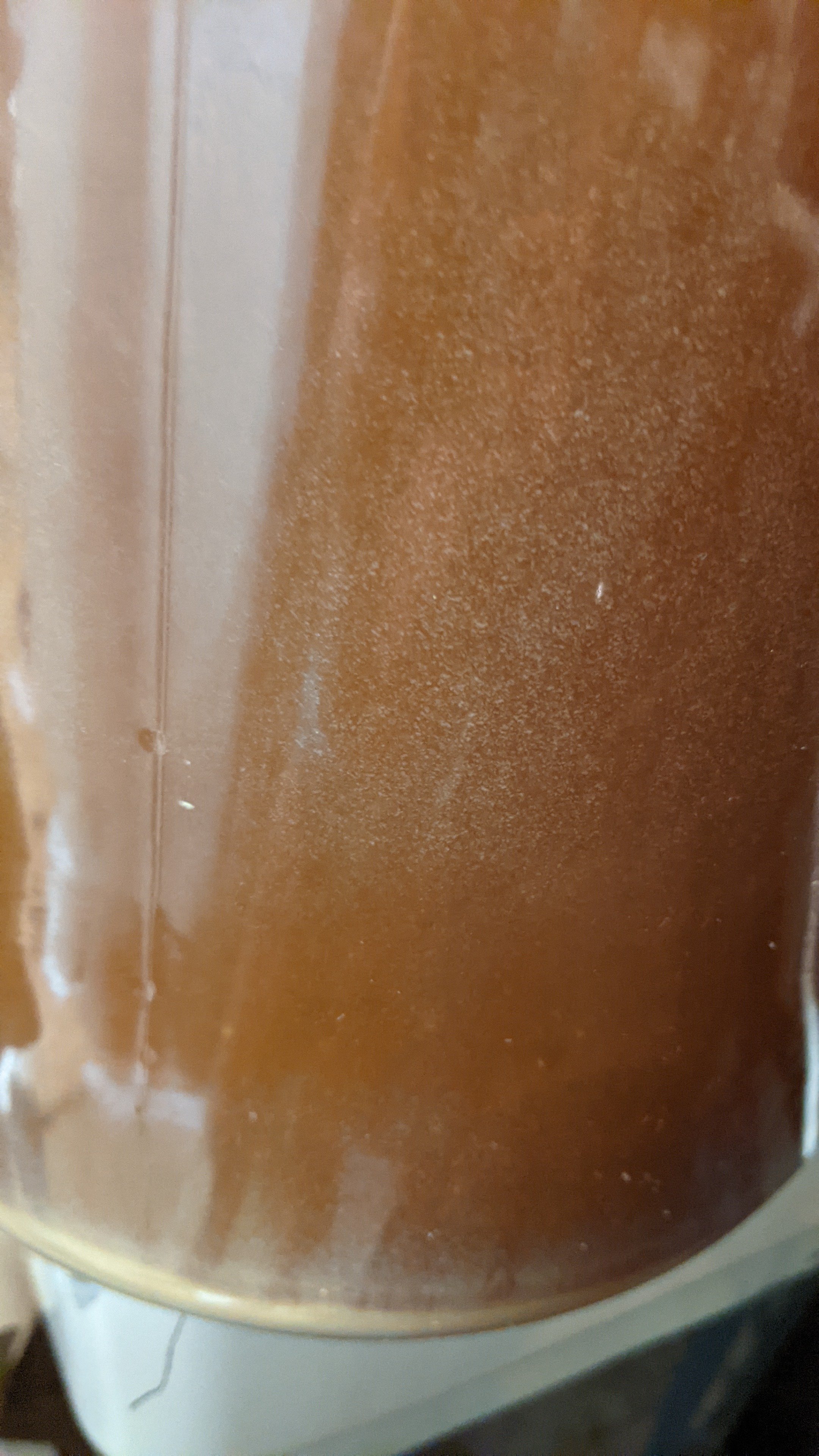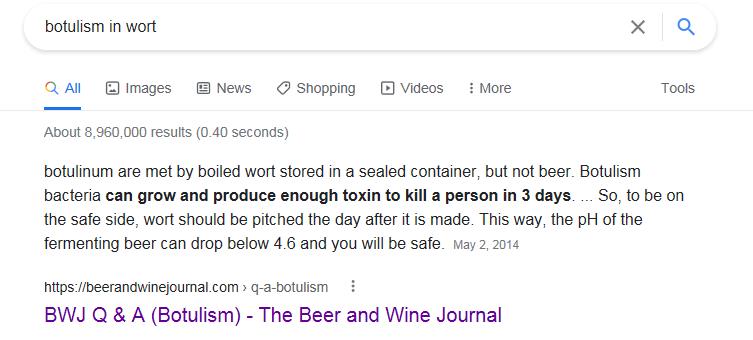You are using an out of date browser. It may not display this or other websites correctly.
You should upgrade or use an alternative browser.
You should upgrade or use an alternative browser.
Uh oh. Wild yeast? Infection?
- Thread starter foscojo
- Start date

Help Support Homebrew Talk:
This site may earn a commission from merchant affiliate
links, including eBay, Amazon, and others.
I concur…. Let it ferment out and condition, and then taste it. If it tastes bad, all you’ve lost is some more time and effort. BUT, you could end up with a very tasty “happy accident”I bet there was some diasticus strain lingering around your fermenter, let us know how it tastes and go from there.
I'm not ordering anybody.. "dude"... The OP asked for our thoughts. My kid is an MD, would you like me to get a professional opinion why you shouldn't drink a bunch of wort that's been mysteriously fermenting or spoiling over the weekend by itself at 100F degrees?Yeah but, there are several users here who do have those qualifications, and I've never seen anything like what you're suggesting coming out of them.
And dude, stop ordering people to dump beers based on your own irrational fears and paranoia.
Use best practices... you are speaking to a lot of people worldwide on this forum with varying levels of skill, education, training, experience. You tell them all to drink this stuff and some will get sick.
Last edited:
Garrett_McT
Seeker of Knowledge, and Homebrew
Honestly I forgot the 100 degree fermentation temp. That is an oddly high temp. Some weird things might be happening. But there are however a handful of professional craft breweries in my area, and many throughout history dating back to pre-hopped beers, who do wild fermentation. It is a very hard task to accomplish, but it can be done. Personally I would honestly stick to preselected lab grown bacteria cultures until I can get a microscope.I'm not ordering anybody.. "dude"... The OP asked for our thoughts. My kid is an MD, would you like me to get a professional opinion why you shouldn't drink a bunch of wort that's been mysteriously fermenting or spoiling over the weekend by itself at 100F degrees?
Use best practices... you are speaking to a lot of people worldwide on this forum with varying levels of skill, education, training, experience. You tell them all to drink this stuff and some will get sick.
I would be interested in and MD opinion. Any bit helps!
sorry I didn’t mean to cause any discourse, it’s just that wild fermentation is a very real thing.
Ok, I googled to see what temp C. botulinum thrives at, and yes, 100F is within the range. However, the acidity of the wort would be close to the tolerance level. Then there are other factors in brewing that I don't think a quick google search will tell me. Hops being one of them. Potentially, the alcohol level at this point being another. Also, I don't know how long it takes for C. botulinum to produce toxins, but what I've read, it mostly happens when something isn't properly canned and has been stored for some amount of time. The wort in question is fresh, so I don't think that it's had time to produce toxins.
@foscojo, what kind of fermentor do you use and what type of yeast was used for the last batch?
Most wild yeast are POF+(phenolic Off flavor positive. think cloves), prior to pitching the Voss, how did it smell?
It is a little late but you might of been better off to dump right away or just let the batch go with whatever was already working then to pitch more yeast.
I am sure having the temp at 100F helped but to get a small trace amount of yeast to build up enough to do a full size batch of beer a couple days seems a bit odd. Might need to revisit your clean routine and if you ferment in plastic might be time for a new fermentor.
Most wild yeast are POF+(phenolic Off flavor positive. think cloves), prior to pitching the Voss, how did it smell?
It is a little late but you might of been better off to dump right away or just let the batch go with whatever was already working then to pitch more yeast.
I am sure having the temp at 100F helped but to get a small trace amount of yeast to build up enough to do a full size batch of beer a couple days seems a bit odd. Might need to revisit your clean routine and if you ferment in plastic might be time for a new fermentor.

$27.29 ($13.64 / Count)
$41.99 ($21.00 / Count)
2 Pack 1 Gallon Large Fermentation Jars with 3 Airlocks and 2 SCREW Lids(100% Airtight Heavy Duty Lid w Silicone) - Wide Mouth Glass Jars w Scale Mark - Pickle Jars for Sauerkraut, Sourdough Starter
Qianfenie Direct

$20.94
$29.99
The Brew Your Own Big Book of Clone Recipes: Featuring 300 Homebrew Recipes from Your Favorite Breweries
Amazon.com

$58.16
HUIZHUGS Brewing Equipment Keg Ball Lock Faucet 30cm Reinforced Silicone Hose Secondary Fermentation Homebrew Kegging Brewing Equipment
xiangshuizhenzhanglingfengshop

$53.24
1pc Hose Barb/MFL 1.5" Tri Clamp to Ball Lock Post Liquid Gas Homebrew Kegging Fermentation Parts Brewer Hardware SUS304(Liquid Hose Barb)
yunchengshiyanhuqucuichendianzishangwuyouxiangongsi

$176.97
1pc Commercial Keg Manifold 2" Tri Clamp,Ball Lock Tapping Head,Pressure Gauge/Adjustable PRV for Kegging,Fermentation Control
hanhanbaihuoxiaoshoudian

$719.00
$799.00
EdgeStar KC2000TWIN Full Size Dual Tap Kegerator & Draft Beer Dispenser - Black
Amazon.com

$22.00 ($623.23 / Ounce)
AMZLMPKNTW Ball Lock Sample Faucet 30cm Reinforced Silicone Hose Secondary Fermentation Homebrew Kegging joyful
无为中南商贸有限公司

$10.99 ($31.16 / Ounce)
Hornindal Kveik Yeast for Homebrewing - Mead, Cider, Wine, Beer - 10g Packet - Saccharomyces Cerevisiae - Sold by Shadowhive.com
Shadowhive

$7.79 ($7.79 / Count)
Craft A Brew - LalBrew Voss™ - Kveik Ale Yeast - For Craft Lagers - Ingredients for Home Brewing - Beer Making Supplies - (1 Pack)
Craft a Brew

$53.24
1pc Hose Barb/MFL 1.5" Tri Clamp to Ball Lock Post Liquid Gas Homebrew Kegging Fermentation Parts Brewer Hardware SUS304(Liquid Hose Barb)
Guangshui Weilu You Trading Co., Ltd
foscojo
Well-Known Member
- Joined
- Jun 23, 2020
- Messages
- 81
- Reaction score
- 17
...what kind of fermentor do you use and what type of yeast was used for the last batch?
...prior to pitching the Voss, how did it smell?
It was a new FerMonster fermenter, so not prior yeast.
When I first opened it, it just smelled like wort. I didn't notice any unexpected odors.
I brewed on Saturday. 5.5 gallons of wort into fermenter at about 5pm. I sent my temp controller to 100F because I cooled it too far and needed to get the temp back up for the Lallemand Voss kviek I am using. But then a family emergency came up before I could pitch the yeast. I just got home on Monday 9am and checked on my fermenter.
I found a pretty high krausen, lots of bubble activity, and debris in the blowoff tubing.
Does that sound like it picked up a wild yeast that took off? Or maybe some kind of infection?
Thoughts?
Roughly the same thing happened to me. Spent seven hours Saturday brewing a saison, didn't get around to pitching the yeast until Monday afternoon. Arrived home Monday to pitch my starter to this:

I dumped it because it reeked of mushrooms growing on wet dogfood. I have no time or desire to find out what innoculated while I wasn't looking. I'm going to Iodophor the whole set up before I reuse it.
foscojo
Well-Known Member
- Joined
- Jun 23, 2020
- Messages
- 81
- Reaction score
- 17
Okay, some good news. So far, it just looks like beer. It was hard to get a pic of the surface through the krausen ring but I didn't see anything growing across it.
Activity is very low now. But that's normal for kviek, I hear. Hard and fast active fermentation.



Activity is very low now. But that's normal for kviek, I hear. Hard and fast active fermentation.



It was a new FerMonster fermenter, so not prior yeast.
When I first opened it, it just smelled like wort. I didn't notice any unexpected odors.
so it smelled like sweet wort and no fermentation like aromas?
Did you check the gravity before pitching the Voss?
With voss you should be about done so you wont have to wait long to taste it if you feel adventurous(or brave).
foscojo
Well-Known Member
- Joined
- Jun 23, 2020
- Messages
- 81
- Reaction score
- 17
so it smelled like sweet wort and no fermentation like aromas?
Did you check the gravity before pitching the Voss?
With voss you should be about done so you wont have to wait long to taste it if you feel adventurous(or brave).
No, I wish I had thought checking the gravity again before pitching the Voss. But yes, it is almost done. Activity has dropped way off to just a of bubble / second, krausen has fallen, yeast cake formed.
Okay, some good news. So far, it just looks like beer. It was hard to get a pic of the surface through the krausen ring but I didn't see anything growing across it.
Activity is very low now. But that's normal for kviek, I hear. Hard and fast active fermentation.
Well, if it turns out well, save the trub and repitch it. You can tell everyone you have a "house strain."
No, I wish I had thought checking the gravity again before pitching the Voss. But yes, it is almost done. Activity has dropped way off to just a of bubble / second, krausen has fallen, yeast cake formed.
As you are bottling I would give it a few extra days to make sure it is done fermenting and verify that with multiple gravity samples. I think you most likely have a cross contamination but if you have something wild it might continue to ferment at a slow pace.
I would also take a small taste of the beer to see if it has off flavors. It does not take much of a sample to get a good idea if it has gone bad.
Garrett_McT
Seeker of Knowledge, and Homebrew
I agree with ba-Brewer, if you took a gravity reading prior to pitching the real yeast culture that would have been a great way of getting a better idea of what you were dealing with. Honestly tracking the SG now until it stabilizes might also help with pointing in a direction of what it is. If it goes below the terminal gravity, it’s a contamination of a bacteria culture. But could still be good, but be cautious
Yes please do. And ask him to be specific. On second thought, nevermind. Brewing science is its own profession and even a fully qualified MD might be clueless.I'm not ordering anybody.. "dude"... The OP asked for our thoughts. My kid is an MD, would you like me to get a professional opinion why you shouldn't drink a bunch of wort that's been mysteriously fermenting or spoiling over the weekend by itself at 100F degrees?
Use best practices... you are speaking to a lot of people worldwide on this forum with varying levels of skill, education, training, experience. You tell them all to drink this stuff and some will get sick.
Whatevs.
Clostridium Botulinum is an anaerobic bacterium requiring an anoxic environment to reproduce. A fermenter under typical conditions does not provide that environment. Home canning=perilous; home brewing=harmless.Ok, I googled to see what temp C. botulinum thrives at, and yes, 100F is within the range. However, the acidity of the wort would be close to the tolerance level. Then there are other factors in brewing that I don't think a quick google search will tell me. Hops being one of them. Potentially, the alcohol level at this point being another. Also, I don't know how long it takes for C. botulinum to produce toxins, but what I've read, it mostly happens when something isn't properly canned and has been stored for some amount of time. The wort in question is fresh, so I don't think that it's had time to produce toxins.
Sounds like your sanitation practices are lacking.Roughly the same thing happened to me. Spent seven hours Saturday brewing a saison, didn't get around to pitching the yeast until Monday afternoon. Arrived home Monday to pitch my starter to this:
View attachment 736233
I dumped it because it reeked of mushrooms growing on wet dogfood. I have no time or desire to find out what innoculated while I wasn't looking. I'm going to Iodophor the whole set up before I reuse it.
Just want to add, maybe you could have 'iodophor'd' the whole set up before racking fresh wort into it and avoided the whole mess? Not trying to be judgy, but 60+ batches here without a single infection, and I suspect some lax sanitation practices.Roughly the same thing happened to me. Spent seven hours Saturday brewing a saison, didn't get around to pitching the yeast until Monday afternoon. Arrived home Monday to pitch my starter to this:
View attachment 736233
I dumped it because it reeked of mushrooms growing on wet dogfood. I have no time or desire to find out what innoculated while I wasn't looking. I'm going to Iodophor the whole set up before I reuse it.
Garrett_McT
Seeker of Knowledge, and Homebrew
You’re opinion becomes important once you get a PhD, where is Chris White at?Just want to add, maybe you could have 'iodophor'd' the whole set up before racking fresh wort into it and avoided the whole mess? Not trying to be judgy, but 60+ batches here without a single infection, and I suspect some lax sanitation practices.
Well, that was concise.But could still be good, but be cautious
A general consensus doesn't create truth, it merely reflects it. That microorganisms dangerous to humans cannot reproduce in beer is widely accepted as fact.
Garrett_McT
Seeker of Knowledge, and Homebrew
And also a very big reason why the federal government changed the laws to allow homebrewing, because some lofty federal organization said that pathogens don’t show up in wort or beer. We are safe to be drunk and be happy! Yay us
VikeMan
It ain't all burritos and strippers, my friend.
- Joined
- Aug 24, 2010
- Messages
- 5,968
- Reaction score
- 6,216
If it goes below the terminal gravity, it’s a contamination of a bacteria culture.
By definition, gravity can't go below terminal gravity. But if you mean gravity below where the pitched strain alone would have taken it, it doesn't necessarily mean a bacterial infection. It could be wild yeast.
Alright Einstein, here is an article from the Beer & Wine Journal that botulism can build up to lethal after 3 days. Here is the article:A general consensus doesn't create truth, it merely reflects it. That microorganisms dangerous to humans cannot reproduce in beer is widely accepted as fact.
https://beerandwinejournal.com/q-a-botulism/
Please stop encouraging people to risk their safety. The whole idea here is safe beer making. You start causing people to do this kind of thing the next thing you will see the government step in... Or maybe some injury attorney will come after you personally...

Stormcrow
Well-Known Member
- Joined
- Apr 14, 2020
- Messages
- 591
- Reaction score
- 661
Crazy. If I didn't know the whole story I'd say that looks like a perfectly normal fermentation. My money is on some kind yeast that went nuts with the high temperature.Okay, some good news. So far, it just looks like beer. It was hard to get a pic of the surface through the krausen ring but I didn't see anything growing across it.
Activity is very low now. But that's normal for kviek, I hear. Hard and fast active fermentation.
View attachment 736235View attachment 736236View attachment 736234
foscojo
Well-Known Member
- Joined
- Jun 23, 2020
- Messages
- 81
- Reaction score
- 17
Do you or anyone you know have a ph meter?
I have a pH test kit for my aquarium and rest strips for the pool.
"nothing that can harm you can survive in beer" but it isn't beer until you pitched the yeast, it was wort. Plenty of harmful bacteria might like to call that home and start multiplying. Are you sure you want to risk it? It's one batch of beer. If it were mine I think I would dump it to be on the safe side.
Beermeister32 has been reading too many Prop65 labels...
Well I "StarSan'd" the entire set up before pumping the wort in. I did exactly nothing different than I've done countless times before. This is my first infection in 10+ years of brewing.Just want to add, maybe you could have 'iodophor'd' the whole set up before racking fresh wort into it and avoided the whole mess? Not trying to be judgy, but 60+ batches here without a single infection, and I suspect some lax sanitation practices.
My best guess is is my batch of StarSan needs replaced and/or since I brew outside, something wild found it's way in. Either way, I shan't leave raw wort sit unattended that long again.
Similar threads
- Replies
- 8
- Views
- 779
- Replies
- 57
- Views
- 5K














































